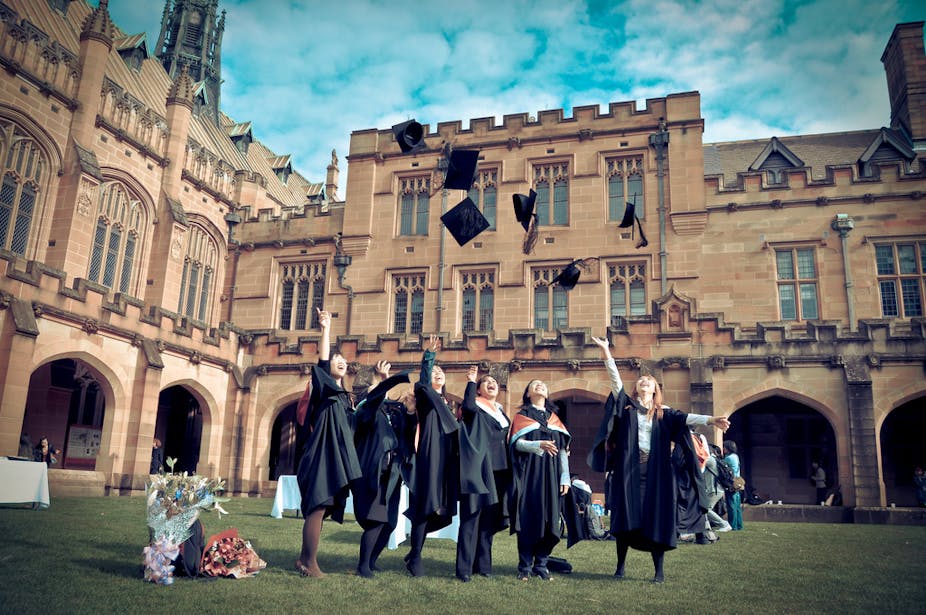In his 2013 election campaign, Tony Abbott promised his government would build a world-class “five pillar economy”, encompassing manufacturing, agriculture, services, education and mining. Two years later, as his government prepares its second federal budget, just how are these sectors faring?
Education is a central pillar of our economy. Not only does the education sector employ nearly 8% of Australian workers, it is our fourth largest export earner, after coal, iron ore and natural gas, bringing in around A$16 billion in 2013/14.
More educated, more social benefits
But what is much more important for us is the contribution that education makes to our society more generally. Economists often talk about education as being an investment in human capital.
What students learn in our schools, vocational education institutions and universities are the skills required to contribute in a modern economy. While estimates of the contribution of this human capital embodied in workers to output vary considerably, recent research suggests that the contribution is large.
While higher education in particular can have considerable benefits for those who study, via gaining better jobs and higher wages, university-educated workers have potential flow-on or ‘spill-over’ benefits for the rest of society.
Economists have found evidence of highly educated workers boosting overall economic growth, and of such workers raising the productivity (and thus wages) of less educated workers who work alongside them.
Education more generally has been found to have other social benefits, including lower crime, improved health, lower utilisation of welfare payments, higher civic participation and improved outcomes for the children of more educated individuals.
Our universities are under-funded
The expansion of higher education in Australia has been rapid. My research using figures from Australian Censuses shows the proportion of working age individuals with a bachelor degree or higher has risen from just 7% in 1981 to 28% in 2011. But government funding of higher education on a per student basis has not kept up with the costs of providing this education.
Student contributions via the HECS (now HELP) system have made up some of this shortfall, but it has not been enough, leading universities to look for revenue elsewhere, particularly from international students.
A university education is far from a ‘sure bet’. Many individuals who have completed a university degree do not obtain a high-paying professional or management level job (28% according to the 2011 Australian Census).
While investing in a university education has a large positive return on average, there is risk that many students will end up with large student loans and little means of paying them off. And this is a risk that is not at all easy for them to diversify.
Higher education is also an investment that is currently not tax deductible. If a firm invests in a piece of capital equipment, or an individual invests in shares or property, the associated costs are tax deductible against income earned from those investments. Individuals cannot deduct the costs of their university education against future potential earnings.
While acknowledging that the individuals who gain most from higher education should contribute to its cost, ensuring that their contribution is set at an appropriate level is very important. Proportionate government subsidisation appears warranted, given that such investments are not currently tax deductible.
If we do not get the cost-sharing balance right, the individual incentive to invest in higher education may become distorted. Given the importance of human capital to our productivity and thus future quality of life, we distort investments in human capital at our peril.
International students provide necessary funding
While the education of international students brings in considerable revenue to higher education institutions, this income has flow-on effects for the rest of the economy.
Workers employed by institutions spend their wages on products and services, which increases employment in Australia. And unlike income from mining exports, the consumers of these education services (the international students) also reside in Australia, further increasing spending on local products and services, particularly food, housing and transport.
These additional university revenues are also used to fund in part the education of Australians, and also important research activities within universities.
One of the main attractions of studying in Australia for our international students is the opportunity of staying in Australia afterwards to work and live in our very attractive society. This opportunity is extremely important in maintaining the competitiveness of studying in Australia relative to our competitors, particularly the UK, the US and Canada. Australia is by no means a cheap destination for international students.
Maintaining our competitiveness in the future will remain a challenge. Tinkering with immigration rules may have consequences for this very important source of revenue for our higher education institutions.
While university rankings are often maligned, international students do look at them. Ensuring Australian universities do not fall down these rankings amid expanding higher education sectors in Asia requires strength in the research performances of our universities.
Education and skills development are central to our society and our material well-being. Ensuring that Australia continues to encourage appropriate investment in education into the future will be a key objective for our policy makers.

